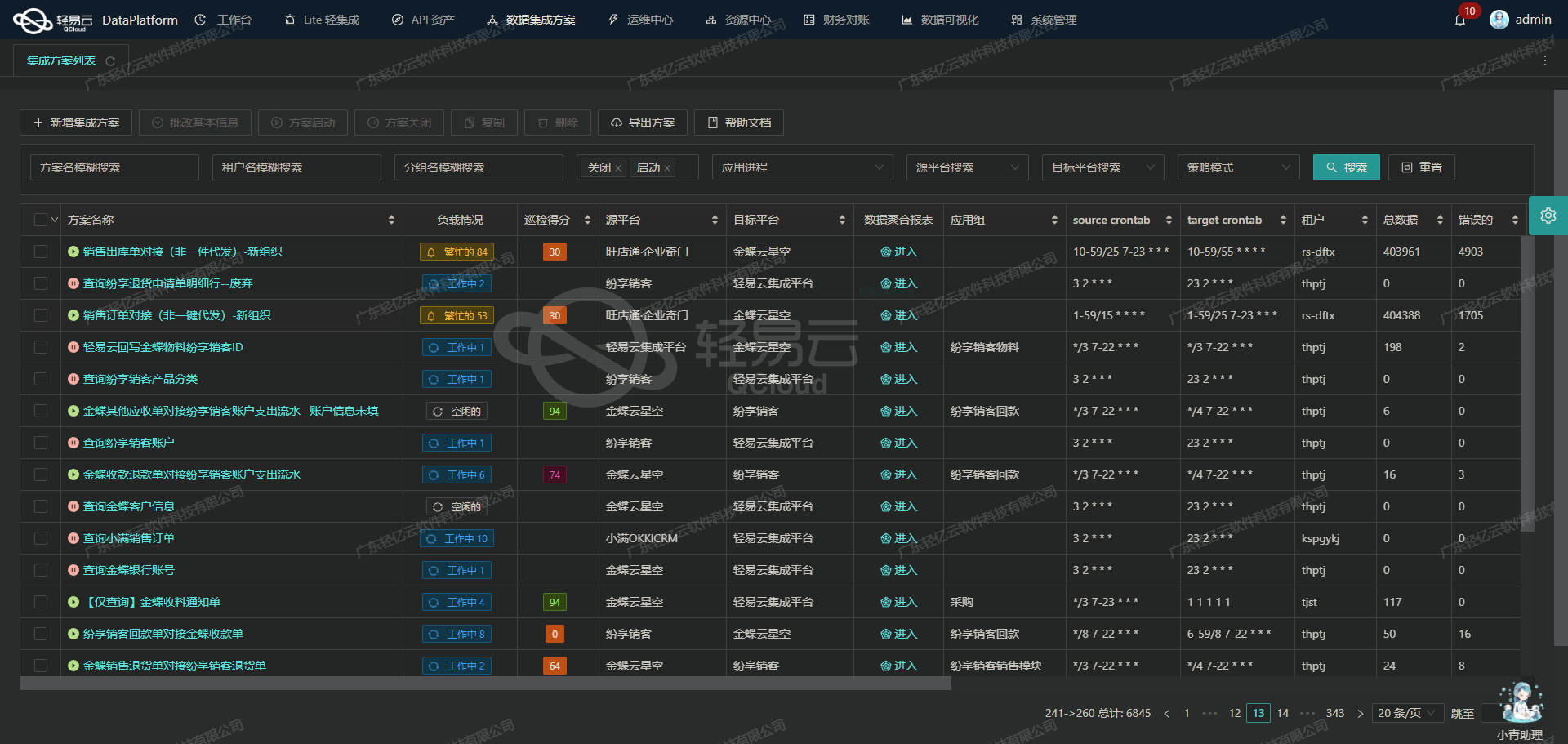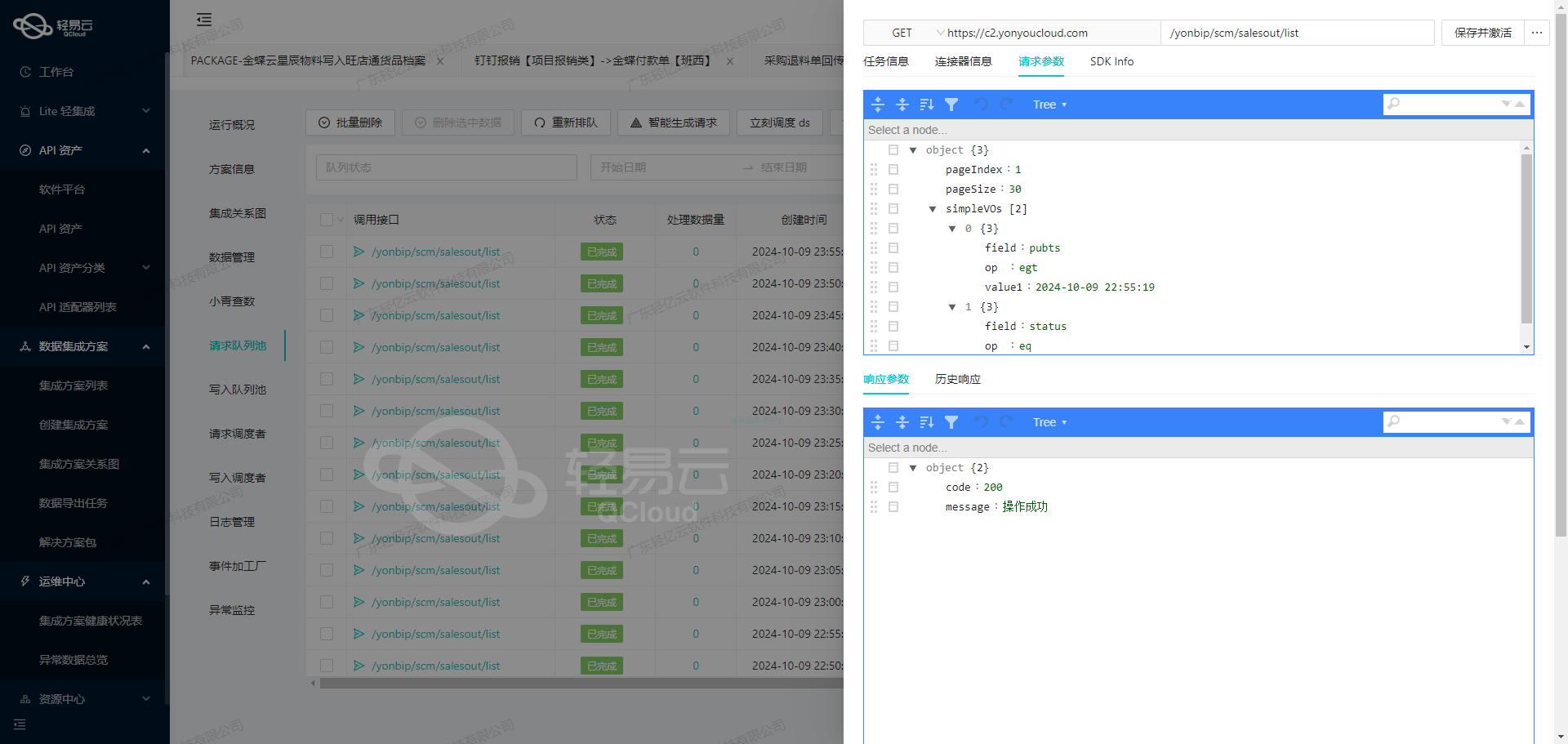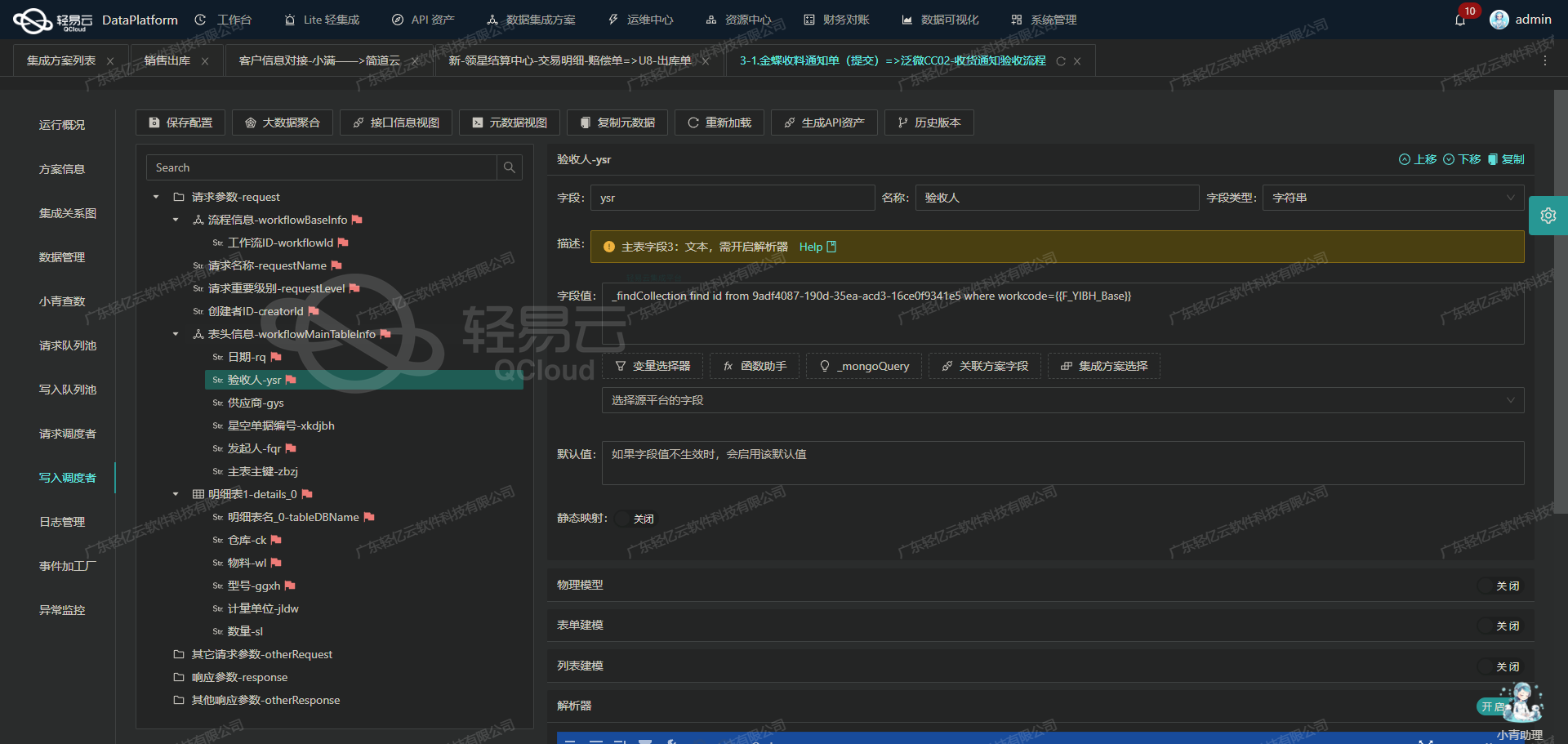金蝶云星空与轻易云平台的数据集成:仓库查询案例解析
在本文中,我们将详细探讨如何通过轻易云数据集成平台实现金蝶云星空系统的数据无缝对接,重点分析在实际项目“仓库查询”中的技术实现方案。该方案涉及到多个关键点,从调用金蝶云星空的executeBillQuery接口开始,到处理分页和限流,再到最终批量写入数据至轻易云集成平台。
调用executeBillQuery接口获取数据
首先,为了从金蝶云星空系统中高效、准确地抓取所需数据信息,我们使用了其提供的标准API——executeBillQuery接口。此过程需要特别注意的是,在执行查询时应确保每次请求参数设置正确,以防止遗漏任何关键信息。此外,合理配置分页策略和限流机制是确保大规模数据传输稳定性的关键步骤,这也是我们首要解决的问题之一。
快速批量写入至轻易云
获得有效的数据后,下一步便是快速且可靠地将这些数据批量写入到轻易云平台上。这里采用了一个优化后的批处理流程,通过并行化操作显著提升了导入速度。在这个过程中,如果遇到格式差异问题,则需要进行实时转换,以保证两端系统之间的数据映射保持一致性。这种方式不仅提高了效率,同时也增强了对大容量数据处理能力的支持。
异常处理与错误重试机制
为了保障整个数据集成过程的稳定性,建立了一套完善的异常处理和错误重试机制。当调用接口发生异常或网络波动导致部分请求失败时,系统会自动识别并触发重试逻辑。此外,还可以通过日志记录功能实时监控每一步操作状态,为后续排查提供参考依据。
通过上述核心环节配置,我们能够确保在多种复杂场景下仍能有效度全生命周期管理各阶段的数据,对业务透明度和整体运营效率都带来了显著提升。

调用金蝶云星空接口executeBillQuery获取并加工数据
在数据集成的生命周期中,调用源系统接口是至关重要的一步。本文将详细探讨如何通过轻易云数据集成平台调用金蝶云星空的executeBillQuery接口,以实现仓库查询的数据获取和加工。
接口配置与请求参数
首先,我们需要了解如何配置和调用金蝶云星空的executeBillQuery接口。根据提供的元数据配置,我们可以看到以下关键参数:
- API:
executeBillQuery - Method:
POST - FormId:
BD_STOCK(业务对象表单Id) - FieldKeys: 需查询的字段key集合
- FilterString: 过滤条件
- Pagination: 分页参数
请求字段配置
元数据配置中的请求字段如下:
{
"request": [
{"field":"FStockId","label":"id","type":"string","value":"FStockId"},
{"field":"FNumber","label":"编码","type":"string","value":"FNumber"},
{"field":"FName","label":"名称","type":"string","value":"FName"},
{"field":"FGroup","label":"分组","type":"string","value":"FGroup"},
{"label":"使用组织","field":"FUseOrgId","type":"string","value":"FUseOrgId.FNumber"}
]
}这些字段对应于金蝶云星空系统中的仓库信息,包括仓库ID、编码、名称、分组和使用组织。
其他请求参数
为了实现分页查询和过滤条件,我们还需要配置以下参数:
{
"otherRequest": [
{"field": "Limit", "label": "最大行数", "type": "string", "describe": "金蝶的查询分页参数", "value": "{PAGINATION_PAGE_SIZE}"},
{"field": "StartRow", "label": "开始行索引", "type": "string", "describe": "金蝶的查询分页参数", "value": "{PAGINATION_START_ROW}"},
{"field": "TopRowCount", "label": "返回总行数", "type": "int", "describe": "金蝶的查询分页参数"},
{"field": "FilterString", "label": "过滤条件", "type": "string", "describe": "",
"value":
`FAuditDate>=to_date('{{LAST_SYNC_TIME|dateTime}}','yyyy-mm-dd hh24:mi:ss')`},
{"field": "FieldKeys",
"label":
`需查询的字段key集合`,
`type`:
`array`,
`describe`:
`金蝶分录主键ID格式:FPOOrderEntry_FEntryId,其它格式 FPurchaseOrgId.FNumber`,
`parser`: {
`name`:
`ArrayToString`,
`params`: ","}},
{"field":
`FormId`,
`label`:
`业务对象表单Id`,
`type`:
`string`,
`describe`:
`必须填写金蝶的表单ID如:PUR_PurchaseOrder`,
`value`:
`"BD_STOCK"`}
]
}这些参数确保我们能够灵活地控制查询结果,包括分页大小、起始行索引以及特定时间段内的数据过滤。
实际调用示例
下面是一个实际调用该接口的示例代码片段:
{
"apiName": "/k3cloud/Kingdee.BOS.WebApi.ServicesStub.DynamicFormService.ExecuteBillQuery.common.kdsvc",
"methodName": "",
"_args_":{
"_args_":[
{
"_args_":[
{
"_args_":[
{
"_args_":[
{
"_args_":[
{
"_args_":[
{
"_args_":[
{
"_args_":[
{
"_args_":[
{
"_args_":[]
}
]
}
]
}
]
}
]
}
]
}
]
}
]
}
]
}
],
"_methodType_":"",
"_methodName_":"",
"_serviceType_":"",
"_serviceName_":"",
"_serviceVersion_":"",
"_serviceNamespace_":"",
"_serviceMethod_":"",
"_serviceArgs_":"",
"__request__":{
"__request__":{
"__request__":{
"__request__":{
"__request__":{
"__request__":{
"__request__":{
"__request__":{
"__request__":{
"__request__":{
"__request__":{
"__request__":{
"__request__":{
"__request__":{
"__request__":{
"__request__":[]
},
"__response__":"",
"__errorCode__":"",
"__errorMessage__":"",
"__statusCode__":"",
"__statusMessage__":"",
"__operationType__":"",
"__operationName__":"",
"__operationVersion__":"",
__operationNamespace__: "",
__operationMethod__: "",
__operationArgs__: ""
},
__response__: "",
__errorCode__: "",
__errorMessage__: "",
__statusCode__: "",
__statusMessage__: "",
__operationType__: "",
__operationName__: "",
__operationVersion__: "",
__operationNamespace__: "",
__operationMethod__: "",
__operationArgs__: ""
},
_response_: "",
_errorCode_: "",
_errorMessage_: "",
_statusCode_: "",
_statusMessage_: "",
_operationType_: "",
_operationName_: "",
_operationVersion_: "",
_operationNamespace_: "",
_operationMethod_: ""
},
response: ""
},
errorCode: ""
},
errorMessage: ""
},
statusCode: ""
},
statusMessage: ""
},
operationType: ""
},
operationName: ""
},
operationVersion: ""
},
operationNamespace: ""
},
operationMethod: ""
},
serviceArgs:[]
}
}
}通过上述代码,我们可以实现对仓库信息的高效查询,并根据需要进行数据清洗和转换。这一步骤在整个数据集成过程中至关重要,为后续的数据写入和处理奠定了基础。
数据清洗与转换
获取到原始数据后,下一步是进行数据清洗和转换。这包括但不限于:
- 去重:确保没有重复记录。
- 格式化:将日期、数字等字段格式化为统一标准。
- 映射:将源系统字段映射到目标系统字段。
例如,对于日期字段,可以使用以下代码进行格式化:
import datetime
def format_date(date_str):
return datetime.datetime.strptime(date_str, '%Y-%m-%d %H:%M:%S').strftime('%Y-%m-%d')
# 示例调用
formatted_date = format_date('2023-10-01 12:00:00')
print(formatted_date) # 输出 '2023-10-01'通过以上步骤,我们可以确保从源系统获取的数据在进入目标系统前已经过充分清洗和转换,符合业务需求。
综上所述,通过轻易云数据集成平台调用金蝶云星空接口executeBillQuery,我们能够高效地获取并加工仓库信息,为后续的数据处理提供坚实基础。

数据转换与写入:轻易云数据集成平台API接口技术案例
在数据集成的过程中,ETL(Extract, Transform, Load)转换是一个至关重要的环节。本文将重点探讨如何将已经集成的源平台数据进行ETL转换,转为目标平台——轻易云集成平台API接口所能够接收的格式,并最终写入目标平台。
API接口配置与调用
在轻易云数据集成平台中,API接口的配置和调用是实现数据写入的关键步骤。根据元数据配置,我们需要使用POST方法来调用“写入空操作”API,并且需要进行ID检查(idCheck: true)。
配置示例
以下是一个典型的API接口配置示例:
{
"api": "写入空操作",
"method": "POST",
"idCheck": true
}数据转换逻辑
在将源平台的数据转换为目标平台可接收的格式之前,我们需要明确以下几点:
- 数据清洗:确保源数据无误,去除重复或无效的数据。
- 字段映射:将源数据中的字段映射到目标平台所需的字段。
- 格式转换:确保数据格式符合目标平台API接口的要求。
示例代码
以下是一个简化的数据转换和写入示例代码:
import requests
import json
# 源数据示例
source_data = [
{"id": 1, "name": "Product A", "quantity": 100},
{"id": 2, "name": "Product B", "quantity": 200}
]
# 转换后的目标数据格式
def transform_data(source_data):
transformed_data = []
for item in source_data:
transformed_item = {
"productId": item["id"],
"productName": item["name"],
"stockQuantity": item["quantity"]
}
transformed_data.append(transformed_item)
return transformed_data
# 调用API接口写入目标平台
def write_to_target_platform(data):
url = "https://api.qingyiyun.com/write"
headers = {"Content-Type": "application/json"}
for item in data:
response = requests.post(url, headers=headers, data=json.dumps(item))
if response.status_code == 200:
print(f"Data written successfully: {item}")
else:
print(f"Failed to write data: {item}, Status Code: {response.status_code}")
# 主流程
transformed_data = transform_data(source_data)
write_to_target_platform(transformed_data)ID检查机制
在元数据配置中,idCheck属性被设置为true,这意味着我们需要在写入之前进行ID检查,以确保不会重复插入相同的数据。这可以通过在调用API之前查询现有记录来实现。
示例代码
def check_id_exists(item_id):
url = f"https://api.qingyiyun.com/check/{item_id}"
response = requests.get(url)
return response.status_code == 200
def write_to_target_platform_with_id_check(data):
url = "https://api.qingyiyun.com/write"
headers = {"Content-Type": "application/json"}
for item in data:
if not check_id_exists(item["productId"]):
response = requests.post(url, headers=headers, data=json.dumps(item))
if response.status_code == 200:
print(f"Data written successfully: {item}")
else:
print(f"Failed to write data: {item}, Status Code: {response.status_code}")
else:
print(f"ID already exists: {item['productId']}")
# 主流程
transformed_data = transform_data(source_data)
write_to_target_platform_with_id_check(transformed_data)实时监控与错误处理
为了确保数据集成过程的可靠性,我们还需要实现实时监控和错误处理机制。可以通过日志记录和异常捕获来实现这一点。
示例代码
import logging
logging.basicConfig(level=logging.INFO)
def write_to_target_platform_with_logging(data):
url = "https://api.qingyiyun.com/write"
headers = {"Content-Type": "application/json"}
for item in data:
try:
if not check_id_exists(item["productId"]):
response = requests.post(url, headers=headers, data=json.dumps(item))
if response.status_code == 200:
logging.info(f"Data written successfully: {item}")
else:
logging.error(f"Failed to write data: {item}, Status Code: {response.status_code}")
else:
logging.warning(f"ID already exists: {item['productId']}")
except Exception as e:
logging.error(f"Exception occurred while writing data: {item}, Error: {str(e)}")
# 主流程
transformed_data = transform_data(source_data)
write_to_target_platform_with_logging(transformed_data)通过上述步骤和示例代码,我们可以高效地将源平台的数据转换并写入到轻易云集成平台,实现不同系统间的数据无缝对接。
